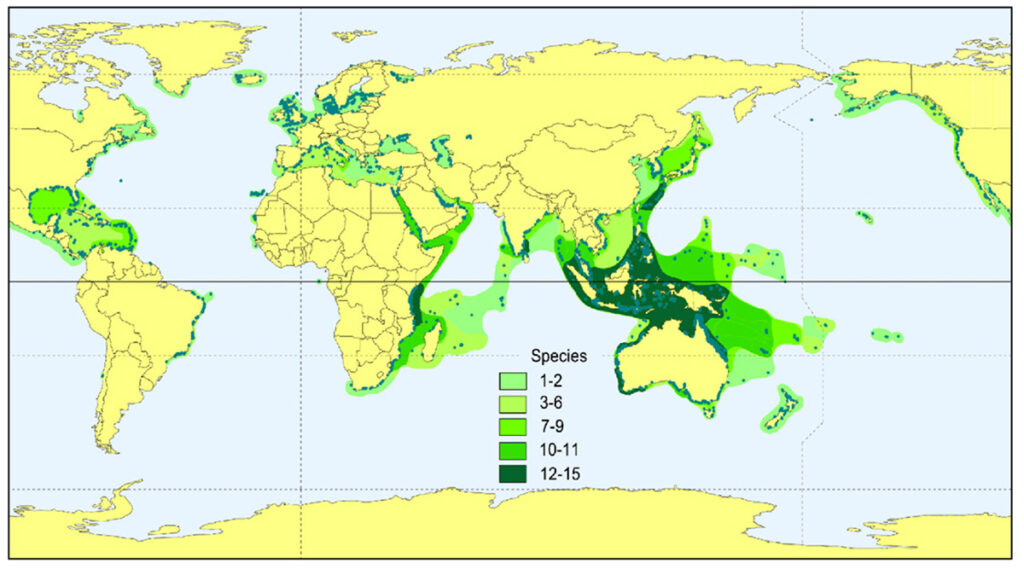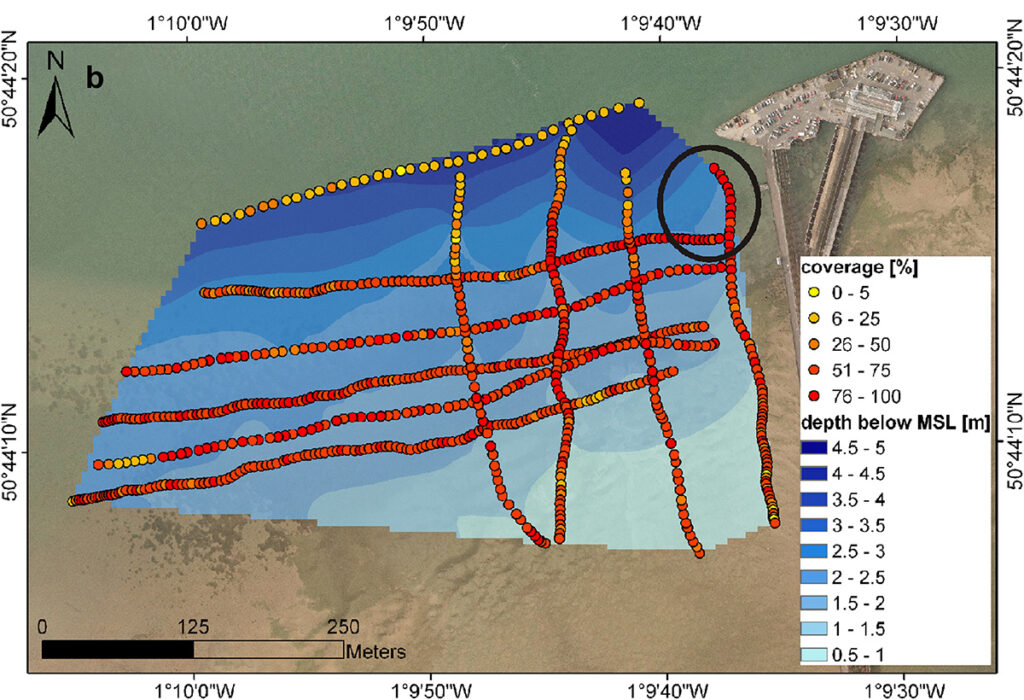How is sound used to monitor and study seagrass beds?

Seagrasses are important marine plants that create a valuable habitat for other marine creatures by forming vast meadows or beds. They resemble and are more closely related to flowering plants on land than seaweed. As many as 76 species of seagrass have been reported around the world.
Seagrass meadows are found in shallow water along coastlines from temperate to tropical regions. In addition to providing habitat, seagrasses are valuable to the ecosystem by cycling nutrients, stabilizing sediment, and sequestering carbon. Despite their key role in coastal ecosystems, seagrass beds worldwide are not well-characterized in terms of area, diversity of species, patchiness, and quantity of carbon sequestration. The study and monitoring of seagrasses increased world-wide starting in the early 2000s as the importance of seagrass beds was recognized, and it became apparent that seagrass beds were declining in many areas.
Acoustic methods can bridge some of the knowledge gaps and can potentially provide low cost monitoring methods in regions with limited resources. The use of acoustics provides larger areal coverage without some of the limitations of more traditional optical methods, such as weather and limited visibility in the water. The most comprehensive studies combine acoustic methods with traditional field surveys and satellite observations.

Acoustic Mapping of Seagrass Beds
A wide variety of acoustic instruments with a broad range of frequencies are used in characterizing seagrass beds, including single beam acoustic systems, side scan sonar, multibeam echosounders, and acoustic doppler current profilers (ADCP). Acoustic methods use the backscatter from the seafloor to detect and estimate seagrass presence and coverage. Some methods allow the estimation of the seagrass canopy height (height above the seafloor). Acoustic methods are particularly effective at detecting within-bed variations on small horizontal scales and are more effective than optical techniques at edges and transition zones around seagrass beds. Periodic field verification of acoustic mapping of seagrass beds is generally required and laboratory studies of acoustic properties of seagrass help refine propagation and backscatter models. Acoustic mapping can be used in very shallow water (1-2 meters) but becomes essential in deeper waters where optical methods may not image seagrass beds.

Seagrass Productivity
Seagrasses produce enough oxygen from photosynthesis to saturate the tissues in the plant, such that oxygen diffuses out, forming bubbles on the surface of the plant leaves, and oxygen dissolves into the surrounding water. When the oxygen levels in the water column reach saturation, bubbles of oxygen persist in the water. Oxygen is also released into the sediment by seagrass roots. The concentration of dissolved oxygen and bubbles of oxygen produced by photosynthesis changes dramatically on a diel cycle in and above a seagrass bed. Dissolved oxygen levels are often above saturation after a few hours of sunlight and remain high into the night.
Oxygen in the plant tissue, on the plant surface, in the sediment, and bubbles in the water column will all lead to the scattering and absorption of sound. Acoustic transmission though a seagrass bed will be reduced by the release of bubbles, with one study measuring a 41 dB decrease in received level in late afternoon during peak bubble production. Changes in sound propagation related to the production and release of oxygen can be used to monitor photosynthetic rates in seagrass beds, with high resolution in time and space.

Chemical sensors are commonly used to measure dissolved oxygen in seagrass beds, from which the photosynthetic rate of the plants can be calculated. However, if a large number of oxygen bubbles exist, these sensors may underestimate photosynthetic rates, because chemical sensors cannot detect bubbles. In contrast, acoustic propagation monitoring is sensitive to changes in oxygen bubbles and can augment chemical sensor studies.
Carbon storage
Seagrass beds are estimated to account for around 10% of the stored carbon in the ocean. Carbon rich sediments (sometimes called mattes) under seagrass beds potentially represent an important sink in the carbon cycle, where carbon could be stored, or sequestered, for hundreds or thousands of years. The full magnitude of the potential carbon storage is uncertain because the carbon stored in seagrass beds is not well-quantified and the processes around sequestration in seagrass beds are not fully understood.
To estimate the carbon storage in seagrass beds, sediment cores are taken and evaluated for carbon content. Sediment core data are extrapolated to the whole bed to get an estimate of total carbon storage. However, there are very sparse core measurements because acquiring and measuring a sediment core is a difficult process that is labor and time intensive. Seagrass bed sediment thickness and carbon content vary widely with position, as shown in the example profile below. Therefore, whole bed estimates from a few cores may not be accurate.

The carbon content of seagrass bed sediments affects acoustic sound speed and attenuation. Acoustic sub-bottom profilers can estimate the sediment depth and carbon content of seagrass beds. Variations in sound speed at different depths can be matched to layers measured in the core, producing more accurate estimates of carbon content across a wider area, and thus, a more complete picture of carbon in the seagrass bed.
Additional links on DOSITS
- Science > Speed of Sound
- Science > Scattering
- Science > Reverberation
- Technology Gallery > Echosounder
- Technology Gallery > Sub-bottom Profiler
- Technology Gallery > Multibeam Echosounder
- Technology Gallery > Side Scan Sonar
- Technology Gallery > ADCP (Acoustic Doppler Current Profiler)
- People > How is sound used to map the seafloor?
Additional Resources
- Smithsonian Ocean – Seagrasses and seagrass beds
References
- Barrell, J., & Grant, J. (2013). Detecting hot and cold spots in a seagrass landscape using local indicators of spatial association. Landscape Ecology, 28(10), 2005–2018. https://doi.org/10.1007/s10980-013-9937-2
- Felisberto, P., Jesus, S. M., Zabel, F., Santos, R., Silva, J., Gobert, S., Beer, S., Björk, M., Mazzuca, S., Procaccini, G., Runcie, J. W., Champenois, W., & Borges, A. V. (2015). Acoustic monitoring of O2 production of a seagrass meadow. Journal of Experimental Marine Biology and Ecology, 464, 75–87. https://doi.org/10.1016/j.jembe.2014.12.013
- Fourqurean, J. W., Duarte, C. M., Kennedy, H., Marbà, N., Holmer, M., Mateo, M. A., Apostolaki, E. T., Kendrick, G. A., Krause-Jensen, D., McGlathery, K. J., & Serrano, O. (2012). Seagrass ecosystems as a globally significant carbon stock. Nature Geoscience, 5(7), 505–509. https://doi.org/10.1038/ngeo1477
- Greene, A., Rahman, A. F., Kline, R., & Rahman, M. S. (2018). Side scan sonar: A cost-efficient alternative method for measuring seagrass cover in shallow environments. Estuarine, Coastal and Shelf Science, 207, 250–258. https://doi.org/10.1016/j.ecss.2018.04.017
- Gumusay, M. U., Bakirman, T., Tuney Kizilkaya, I., & Aykut, N. O. (2019). A review of seagrass detection, mapping and monitoring applications using acoustic systems. European Journal of Remote Sensing, 52(1), 1–29. https://doi.org/10.1080/22797254.2018.1544838
- Hossain, M. S., Bujang, J. S., Zakaria, M. H., & Hashim, M. (2015). The application of remote sensing to seagrass ecosystems: An overview and future research prospects. International Journal of Remote Sensing, 36(1), 61–114. https://doi.org/10.1080/01431161.2014.990649
- Lee, K. M., Ballard, M. S., Venegas, G. R., Sagers, J. D., McNeese, A. R., Johnson, J. R., Wilson, P. S., & Rahman, A. F. (2019). Broadband sound propagation in a seagrass meadow throughout a diurnal cycle. The Journal of the Acoustical Society of America, 146(4), EL335–EL341. https://doi.org/10.1121/1.5127737
- Lefebvre, A., Thompson, C. E. L., Collins, K. J., & Amos, C. L. (2009). Use of a high-resolution profiling sonar and a towed video camera to map a Zostera marina bed, Solent, UK. Estuarine, Coastal and Shelf Science, 82(2), 323–334. https://doi.org/10.1016/j.ecss.2009.01.027
- Lo Iacono, C., Mateo, M. A., Gràcia, E., Guasch, L., Carbonell, R., Serrano, L., Serrano, O., & Dañobeitia, J. (2008). Very high-resolution seismo-acoustic imaging of seagrass meadows (Mediterranean Sea): Implications for carbon sink estimates. Geophysical Research Letters, 35(18), L18601. https://doi.org/10.1029/2008GL034773
- Paul, M., Lefebvre, A., Manca, E., & Amos, C. L. (2011). An acoustic method for the remote measurement of seagrass metrics. Estuarine, Coastal and Shelf Science, 93(1), 68–79. https://doi.org/10.1016/j.ecss.2011.04.006
- Ricart, A. M., York, P. H., Bryant, C. V., Rasheed, M. A., Ierodiaconou, D., & Macreadie, P. I. (2020). High variability of Blue Carbon storage in seagrass meadows at the estuary scale. Scientific Reports, 10(1), 5865. https://doi.org/10.1038/s41598-020-62639-y
- Short, F., Carruthers, T., Dennison, W., & Waycott, M. (2007). Global seagrass distribution and diversity: A bioregional model. Journal of Experimental Marine Biology and Ecology, 350(1–2), 3–20. https://doi.org/10.1016/j.jembe.2007.06.012
- Van Dam, B. R., Zeller, M. A., Lopes, C., Smyth, A. R., Böttcher, M. E., Osburn, C. L., Zimmerman, T., Pröfrock, D., Fourqurean, J. W., & Thomas, H. (2021). Calcification-driven CO 2 emissions exceed “Blue Carbon” sequestration in a carbonate seagrass meadow. Science Advances, 7(51). https://doi.org/10.1126/sciadv.abj1372
- Venegas, G. R., Rahman, A. F., Lee, K. M., Ballard, M. S., & Wilson, P. S. (2019). Toward the Ultrasonic Sensing of Organic Carbon in Seagrass‐Bearing Sediments. Geophysical Research Letters, 46(11), 5968–5977. https://doi.org/10.1029/2019GL082745
- Wilson, C. J., Wilson, P. S., & Dunton, K. H. (2012). An acoustic investigation of seagrass photosynthesis. Marine Biology, 159(10), 2311–2322. https://doi.org/10.1007/s00227-012-2016-4
- Wilson, P. S., & Dunton, K. H. (2009). Laboratory investigation of the acoustic response of seagrass tissue in the frequency band 0.5–2.5 kHz. The Journal of the Acoustical Society of America, 125(4), 1951–1959. https://doi.org/10.1121/1.3086272